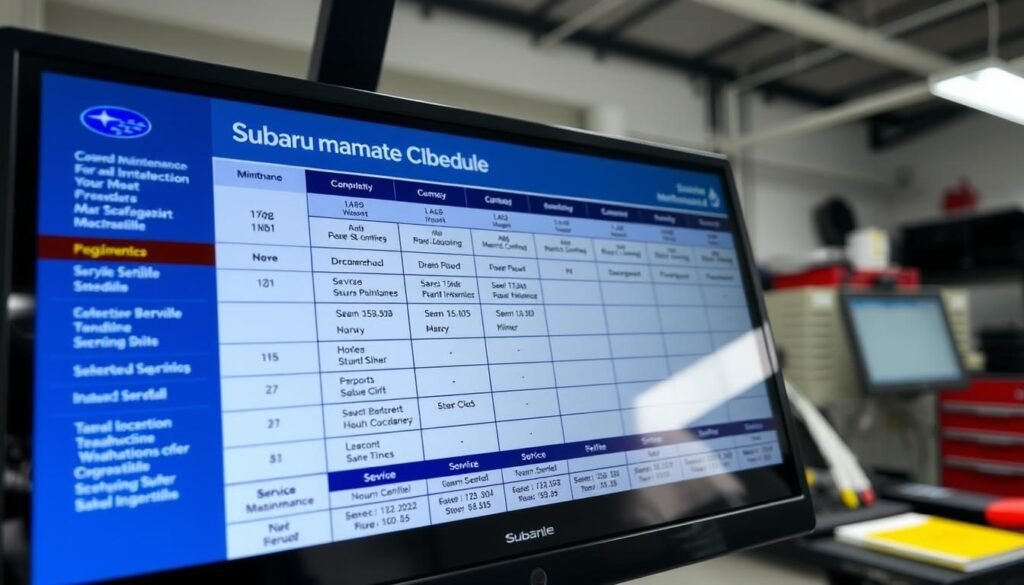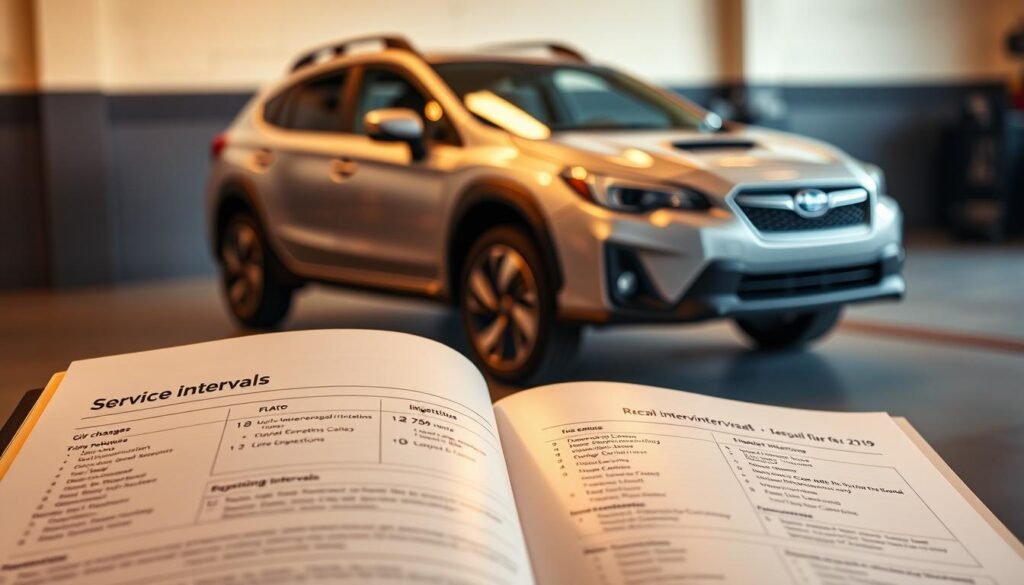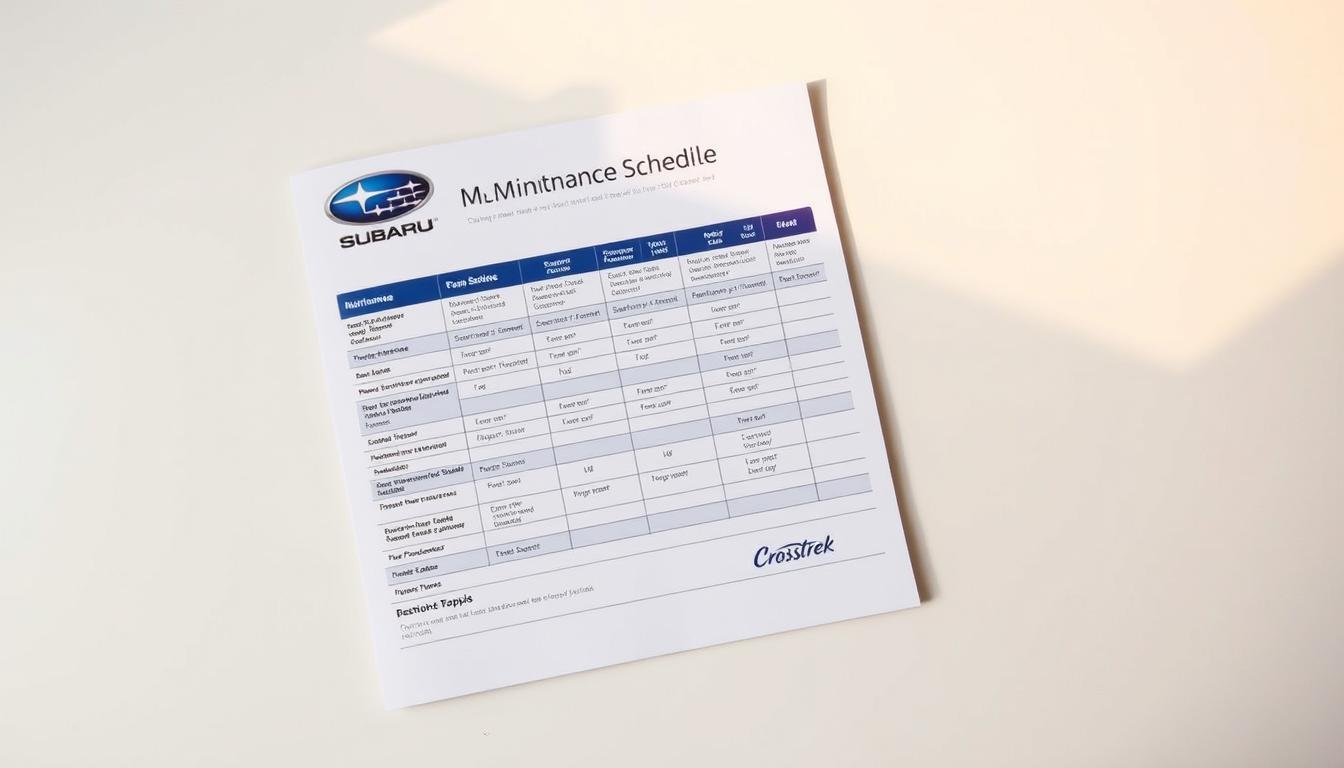Subaru Crosstrek Maintenance Schedule Guide & Intervals
Want your Subaru Crosstrek maintenance schedule to perform at its best? It’s crucial to follow a detailed maintenance schedule.
Doing regular tasks like changing oil and filters every 6,000 miles keeps your car running smoothly. Checking the air cleaner and rotating tires are also key.
Our Subaru Crosstrek maintenance guide tells you what services are needed and when. For example, replace the air and cabin filters at 12,000 miles.
At 30,000 miles, it’s time to check your engine coolant and brake fluid. Remember, a thorough check-up is needed every 30 months or 30,000 miles for your safety and the car’s efficiency.
Maintaining your car regularly is super important. By sticking to this guide, your Subaru Crosstrek will stay in excellent shape and be ready for adventure.
With careful maintenance, your car will perform well and keep you safe. Now, let’s learn more about keeping your Crosstrek reliable for the long haul.
Introduction To Subaru Crosstrek Maintenance
Maintaining your Subaru Crosstrek is key to keeping it running smoothly for a long time. It makes your drives better and gives you peace of mind.
By following the recommended maintenance schedule, you know exactly when your car needs servicing. Sticking to the service intervals helps avoid big problems later.
With regular maintenance, your Crosstrek can reach 200,000 miles. This improves its reliability and performance. For example, changing the oil every 6,000 miles is vital for the engine.
Regular maintenance lowers the chance of big repairs. It can reduce the need for major fixes by 7% in five years. Inspections, including looking at tires and fluid levels, keep your Crosstrek ready for the road.
By keeping up with maintenance, you are investing in your car’s future. This commitment pays off by ensuring a smoother, more efficient drive for years.
Importance of Regular Maintenance For Your Subaru Crosstrek
Keeping up with regular maintenance keeps your Subaru Crosstrek running smoothly and safely. If you skip it, you could face big problems and high costs.
By following good maintenance advice, you can avoid breakdowns, save fuel, and make your car last longer. Regular checks help spot small issues before they turn into big, expensive ones.
Over 10 years, maintaining a Subaru Crosstrek costs about $8,210. This is less than what other popular SUVs cost to keep up. This shows how staying on top of maintenance can save you both money and time.
There’s about a 24% chance you’ll need major repairs in the first 10 years of owning your Crosstrek. But in the first five years, that chance drops to just 7%.
These numbers show why it’s key to follow your car’s maintenance schedule to keep it reliable.
| Year | Major Repair Probability |
|---|---|
| 1 | 2.47% |
| 2 | 4.10% |
| 3 | 4.60% |
| 4 | 8.13% |
| 5 | 11.64% |
| 6 | 13.10% |
| 7 | 14.13% |
| 8 | 18.26% |
| 9 | 20.18% |
| 10 | 23.97% |
Making time for your car’s maintenance boosts its value and keeps you safe on the road. With the best Subaru Crosstrek maintenance tips, your car will perform great and last a long time.
What is the Subaru Crosstrek Maintenance Schedule?
Keeping up with the Subaru Crosstrek’s maintenance schedule is key for its longevity and performance. A good service plan helps you keep track of maintenance work, making your drives better.
Here, you’ll discover the maintenance tasks needed at certain mileage points, and why sticking to this plan is beneficial.
Recommended Maintenance Tasks by Mileage
Using the Subaru Crosstrek maintenance checklist ensures your car runs smoothly for a long time. Below, you’ll find important tasks to do at various mileages:
| Mileage Milestone | Recommended Maintenance Tasks |
|---|---|
| 6,000 miles | Engine oil replacement, engine oil filter replacement, tire rotation and inspection |
| 12,000 miles | A/C filter replacement, brake line inspection, steering and suspension inspection, engine oil and filter change |
| 60,000 miles | Spark plug replacement, wheel bearing inspection |
| 137,000 miles | Replace and refill all fluids, check major components (engine, transmission, brake system) |
Benefits of Following The Maintenance Schedule
There are lots of benefits to following the Subaru Crosstrek’s service schedule:
- It makes your car more reliable and safe to drive.
- Your fuel efficiency gets better, saving you money.
- You’ll have fewer big repairs later on.
- You won’t have to worry about how your car is running.
Keeping up with these tasks means your drive will always be dependable. Plus, you’re protecting your investment in the Subaru Crosstrek.

Subaru Crosstrek Service Intervals Explained
It’s key to know Subaru Crosstrek service intervals to keep your car running well. They split into short-term and long-term care. This knowledge keeps your vehicle working great.
Short-Term vs. Long-Term Service Needs
Short-term care involves routine checks every 7,500 miles. Tasks include:
- Oil changes
- Tire rotations
- Fluids checks
Long-term care means bigger checks and replacements around every 105,000 miles. These include:
- Timing belt replacement
- Spark plug changes
- Comprehensive engine inspections
By knowing these Subaru Crosstrek service times, you won’t miss important maintenance. Following this plan makes your car more reliable for longer.

Subaru Crosstrek Maintenance Checklist: Essential Items
Keep your Subaru Crosstrek in top shape by following a detailed maintenance checklist. It covers everything necessary, from engine to tires. Here are the key areas to watch:
Routine Checks For Engine Health
- Engine Oil: Change oil every 6,000 miles or every six months, whichever comes first.
- Air Filters: Replace engine air filter and cabin air filter every 65,000 miles.
- Coolant Hoses: Inspect coolant hoses and battery condition during the 10,000-mile service.
- Throttle Body: Clean the throttle body if experiencing stalling or hesitation issues.
Fluid Levels and Tire Maintenance
- Fluid Levels: Regularly check brake fluid, coolant, and transmission fluid levels.
- Tire Pressure: Ensure proper tire pressure is maintained; rotate tires every 5,000 miles.
- Brake System: Inspect front and rear brakes during the 25,000-mile service.
- Fuel System: Inspect the fuel system at the 25,000-mile milestone for optimal performance.

Key Components in Subaru Crosstrek Maintenance
To keep your Subaru Crosstrek running well, you need to look after a few important parts. These include changing the engine oil, taking care of the brakes, and replacing the air filter.
Doing these things helps your car perform at its best for a longer time.
Engine Oil and Filter Changes
Changing the engine oil and filter regularly is key to keeping your Crosstrek’s engine healthy. You should do this every 6 months or after driving 6,000 miles.
If you often drive in tough conditions, change the oil every 3,000 miles or every 3 months. This keeps your engine working well and avoids big damage later on.
Brake System Maintenance
The brake system is essential for your Subaru Crosstrek. It’s important to check the brake pads, rotors, and fluid levels regularly. Get these inspections done every 6 months or after driving a lot.
This helps you catch any issues early, making sure your brakes work well. Good brakes improve your car’s safety and how it drives.
Air Filter Replacements
Replacing the air filter is crucial for a clean engine intake system. You should replace the air cleaner element about every 30,000 miles. If you drive in dusty places, check and replace it more often.
This keeps the air flow and engine efficiency at their best. A dirty air filter lowers your car’s performance and increases emissions.

| Maintenance Task | Frequency | Notes |
|---|---|---|
| Engine Oil Change | Every 6 months or 6,000 miles | Every 3 months or 3,000 miles under severe conditions |
| Brake System Inspection | Every 6 months | Monitor brake pads, rotors, and fluid |
| Air Filter Replacement | Every 30,000 miles | Increase frequency in dusty driving conditions |
Common Subaru Crosstrek Maintenance Issues
If you own a Subaru Crosstrek, know the maintenance issues that might pop up. These include oil leaks, tire wear, and brake problems. Being ahead of these problems means fewer surprises down the road.
Your car has a maintenance schedule to keep it running smooth. By 6,000 miles, change your engine oil and filter, and check your tires. This keeps the engine happy and your tires wearing evenly.
When you hit 12,000 miles, it’s time for more checks. Change the A/C filter, look at the clutch, and check the brakes and suspension. If your brakes squeak, they need a quick look.
At 30,000 miles, your Subaru needs a bigger check-up. This includes a new air cleaner element and checks on fluids and the drivetrain. If your car shudders or hesitates when accelerating, check the CVT fluid.
Keep up with these issues and your maintenance schedule for a reliable drive. Regular checks and fixes keep your Crosstrek running well.
Sourcing Quality Parts For Maintenance
When you’re looking after your vehicle, picking quality parts is key for its long life and performance. You have two main choices: genuine OEM parts or aftermarket options. Each has its benefits and downsides.
Knowing these differences makes it easier to choose the right parts for your car, based on what you need and how much you want to spend.
Genuine OEM vs. Aftermarket Parts
Genuine OEM parts come straight from Subaru. They match your car perfectly, offering top performance. They might cost more, but their reliability often makes them worth it.
This is especially true for important parts. On the other hand, aftermarket parts are usually cheaper. They give you more choices too. But the quality isn’t always as good, so it’s important to do your homework.
Think about these points from your Subaru Crosstrek maintenance guide when looking for parts:
- Quality Assurance: OEM parts ensure a perfect fit and smooth performance, reducing future problems.
- Cost-Efficiency: Aftermarket parts can be cheaper now, but might cost more if they fail sooner.
- Warranty Considerations: Using aftermarket parts might change your warranty. It’s important to check.
- Availability: Sometimes, you can only get certain parts as OEM, which you’ll need for some repairs.
To sum it up, choosing between genuine OEM and aftermarket parts impacts how well your Subaru Crosstrek is maintained. Using the right parts will not only make your car run better but also last longer.
Subaru Crosstrek Maintenance Tips For Longevity
Your driving style greatly impacts your Subaru Crosstrek’s health. It’s key to know how your habits can affect its performance.
Driving gently leads to less damage, while rough driving can harm engine parts and brakes. With the right maintenance tips, your Crosstrek can last longer and perform better.
Driving Habits That Impact Maintenance
To make your Crosstrek last longer, think about how you drive:
- Avoid speeding up quickly and stopping suddenly. These habits can speed up wear and tear.
- Keep a steady speed, especially on highways. This improves gas mileage and lowers engine stress.
- Use cruise control when you can. It helps keep speed even and eases engine work.
- Check your tire pressure often. Losing 1 PSI can make you use up to 3% more fuel.
Seasonal Maintenance Considerations
Getting your Subaru Crosstrek ready for the changing seasons is vital for its care. Here are some tips for each season:
- Winter: Switch to winter tires and check coolant every 30,000 miles or two years.
- Summer: Check the air conditioning and keep fluids topped up to avoid overheating.
- Spring: Give your car a good wash to prevent rust, which can help it keep up to 20% more value when you sell it.
- Fall: Have your brakes checked to stay safe during heavier travel and bad weather.
Cost of Maintenance Over Time
It’s crucial to know how much you’ll spend on your Subaru Crosstrek maintenance. Over ten years, costs for upkeep and minor fixes are about $8,210.
This amount covers regular checks and small repairs. By understanding these costs, you can budget for both planned and unplanned expenses.
Estimated Annual Maintenance Costs
The yearly repair cost for a Subaru averages $617. You’ll likely visit a repair shop about 0.3 times a year. Most issues can be avoided with regular maintenance.
Here’s a list of common repair costs:
| Repair Task | Estimated Cost |
|---|---|
| Wheel Alignment | $106 – $133 |
| Coolant Leak Diagnosis | $44 – $56 |
| Battery Cable Service | $26 – $33 |
| Suspension System Inspection | $70 – $89 |
| AC Diagnosis | $88 – $111 |
| General Diagnosis | $88 – $111 |
Major Repairs To Be Aware Of
Prepare for big repairs, like head gasket failures or CVT transmission problems. There’s a 13% chance you might face a severe repair. Subaru has recalled its cars 13 times.
A common issue is brake light switch problems. Knowing these problems lets you fix them early, saving money in the long run.
Conclusion
It’s key to follow a Subaru Crosstrek maintenance plan to keep your car working well. Keeping up with the set service times boosts your car’s performance and life.
Getting regular check-ups can catch issues early, saving you money on repairs. Doing things like changing oil on time, checking brakes, and looking at tire wear is important for safety.
Since most cars run into at least one issue, regular checks on your Subaru Crosstrek cut down on risks. This is extra important as the weather changes, affecting your car in different ways.
To get the most out of your Subaru Crosstrek, keep up with maintenance. Plan routine inspections and keep an eye out for events like Baldwin Subaru’s Fall Service Event for special deals.
This way, you’ll have a safer, more dependable car for years to come.
FAQs
What is the recommended maintenance schedule for the Subaru Crosstrek?
For the Subaru Crosstrek, you should change the oil every 7,500 miles. You also need to rotate the tires and check fluids at certain miles. Always check your owner’s manual for the exact plan.
How often should I perform a tire rotation on my Subaru Crosstrek?
Rotate your tires around every 7,500 miles. This helps them wear evenly and keeps your car handling well.
What are the key components to inspect during routine maintenance?
Make sure to inspect engine oil, brakes, and tire pressure. Also, check the levels of your brake, coolant, and transmission fluids. Don’t forget to visually inspect belts and hoses too.
How can I identify when my Subaru Crosstrek needs maintenance?
Watch out for dashboard warning lights and strange noises. A drop in your car’s performance can also be a sign. Regular checks and following the maintenance schedule are key to spotting service needs early.
What distinguishes genuine OEM parts from aftermarket options for maintenance?
Genuine OEM parts come straight from Subaru, guaranteeing a perfect fit and reliability. Aftermarket parts might be cheaper, but they can vary in quality. Choose based on what you value more: cost or assurance.
How do aggressive driving habits affect my Crosstrek’s maintenance needs?
Driving hard puts extra stress on your engine and brakes. This means you’ll need to check and fix things more often to prevent damage.
What are common maintenance issues to watch for with my Subaru Crosstrek?
Keep an eye out for oil leaks, unusual tire wear, and brake problems. Spotting these issues early through regular checks can save you time and money.
What is the estimated cost of maintenance for my Subaru Crosstrek over time?
Expect to spend about ,210 on maintenance and repairs over ten years. Staying on top of regular maintenance can help avoid bigger, more expensive problems down the road.







